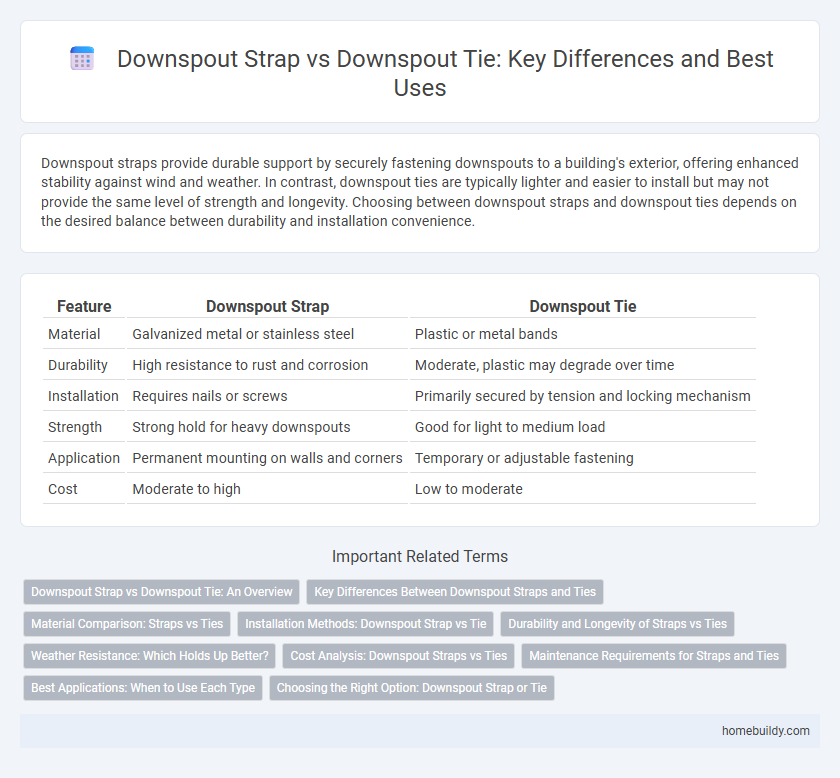Downspout straps provide durable support by securely fastening downspouts to a building's exterior, offering enhanced stability against wind and weather. In contrast, downspout ties are typically lighter and easier to install but may not provide the same level of strength and longevity. Choosing between downspout straps and downspout ties depends on the desired balance between durability and installation convenience.
Table of Comparison
| Feature | Downspout Strap | Downspout Tie |
|---|---|---|
| Material | Galvanized metal or stainless steel | Plastic or metal bands |
| Durability | High resistance to rust and corrosion | Moderate, plastic may degrade over time |
| Installation | Requires nails or screws | Primarily secured by tension and locking mechanism |
| Strength | Strong hold for heavy downspouts | Good for light to medium load |
| Application | Permanent mounting on walls and corners | Temporary or adjustable fastening |
| Cost | Moderate to high | Low to moderate |
Downspout Strap vs Downspout Tie: An Overview
Downspout straps provide a durable and secure attachment for downspouts to a building's exterior, typically made from heavy-gauge metal for enhanced weather resistance. Downspout ties, often made from softer, more flexible materials, offer a temporary or adjustable solution ideal for quick repairs or lightweight installations. Choosing between downspout strap vs downspout tie depends on the need for long-term durability versus ease of installation and flexibility.
Key Differences Between Downspout Straps and Ties
Downspout straps are typically wider and flatter, providing strong support by wrapping around the downspout and securing it to the building's exterior, while downspout ties are often narrower and more flexible, designed for quick attachment and adjustment. Straps offer enhanced durability and resistance to weather conditions, making them ideal for long-term installations, whereas ties prioritize ease of use and may suit temporary or less demanding applications. Material composition also varies, with metal straps offering robust reinforcement compared to plastic or rubber ties that provide less rigidity.
Material Comparison: Straps vs Ties
Downspout straps are typically made from heavy-gauge galvanized steel or aluminum, offering superior strength and resistance to corrosion compared to downspout ties, which are often manufactured from flexible materials like plastic or rubber. Straps provide a more rigid and durable fastening solution, capable of securely holding downspouts in place during harsh weather conditions. Ties, while easier to install and more affordable, may degrade over time due to UV exposure and lack the structural support needed for heavy-duty applications.
Installation Methods: Downspout Strap vs Tie
Downspout straps are usually installed by wrapping the strap around the downspout and securing it to the wall with screws or nails, offering a tight and durable hold. In contrast, downspout ties often use wire or metal bands twisted around the downspout and fastened to the structure, providing a more adjustable but potentially less stable attachment. Installation of downspout straps generally requires fewer adjustments and delivers a more permanent solution compared to the flexible but less sturdy nature of downspout ties.
Durability and Longevity of Straps vs Ties
Downspout straps are typically made from heavy-gauge metal or stainless steel, offering superior durability and resistance to rust compared to downspout ties, which are often constructed from plastic or lighter metal materials. The enhanced strength and corrosion resistance of straps ensure they maintain secure attachment over longer periods, reducing the need for frequent replacements. Straps provide better longevity in harsh weather conditions, making them a more reliable choice for long-term downspout support.
Weather Resistance: Which Holds Up Better?
Downspout straps, typically made from heavy-gauge galvanized steel or stainless steel, offer superior weather resistance compared to downspout ties, which are often constructed from plastic or rubber materials prone to cracking and degradation over time. The metal composition of downspout straps withstands harsh UV exposure, temperature fluctuations, and moisture, ensuring long-lasting durability in various climates. For homeowners seeking maximum lifespan and minimal maintenance, downspout straps provide a robust solution that better resists rust, corrosion, and environmental wear than downspout ties.
Cost Analysis: Downspout Straps vs Ties
Downspout straps typically offer a cost-effective solution with durable galvanized steel construction, averaging $0.50 to $1.50 per strap, while downspout ties, often made of plastic or metal, range from $1 to $3 depending on material and brand. Installation time and tool requirements influence overall expenses, with straps generally requiring basic tools and less labor compared to ties, which may need specialized clips or fasteners. Evaluating long-term maintenance costs, straps resist rust and weathering better, reducing replacement frequency and providing greater value for budget-conscious projects.
Maintenance Requirements for Straps and Ties
Downspout straps require periodic tightening and inspection to prevent loosening from weather exposure, ensuring the downspout remains securely attached to the structure. Downspout ties generally demand more frequent maintenance due to their thinner material, which can degrade faster and may need replacement to maintain stability. Properly maintained straps typically offer longer-term durability and reduce the frequency of repairs compared to ties.
Best Applications: When to Use Each Type
Downspout straps provide strong support for securing downspouts to a building's exterior, making them ideal for heavy or larger downspouts exposed to high wind or weight stress. Downspout ties, which are generally thinner and more flexible, work best for lighter downspouts or temporary installations where ease of adjustment is important. Choosing between straps and ties depends on factors such as downspout size, environmental conditions, and the level of durability required for long-term stability.
Choosing the Right Option: Downspout Strap or Tie
Downspout straps provide strong, secure support for heavy downspouts, making them ideal for withstanding high wind loads and preventing damage. Downspout ties offer a more flexible and affordable option for lighter applications, suitable for temporary or less demanding installations. Evaluating the material durability, installation environment, and weight of the downspout helps determine whether a strap or tie is the most effective choice.
Downspout strap vs Downspout tie Infographic

 homebuildy.com
homebuildy.com